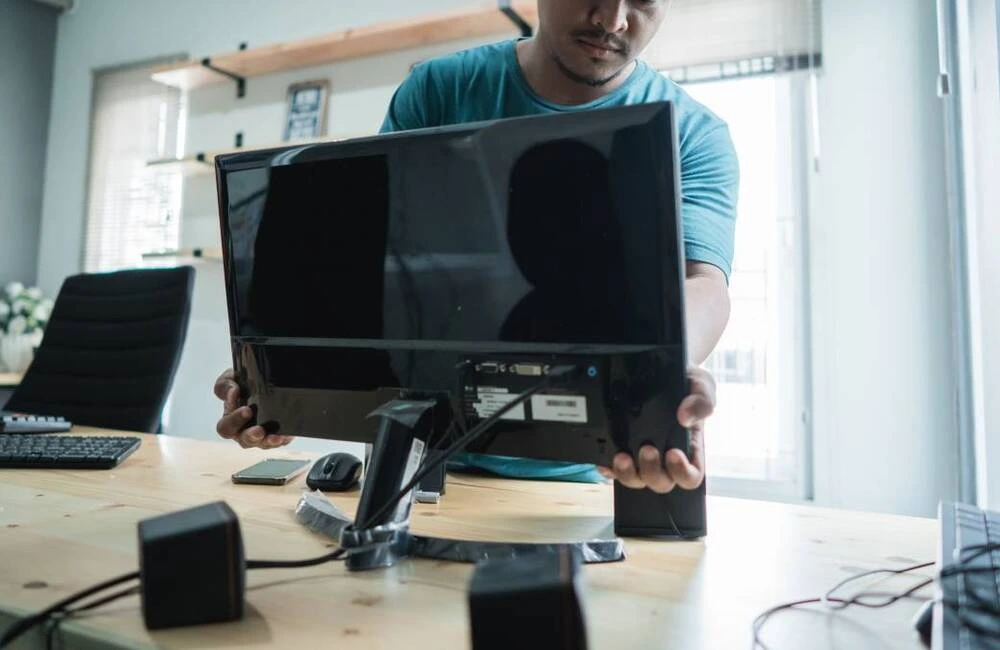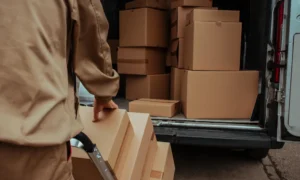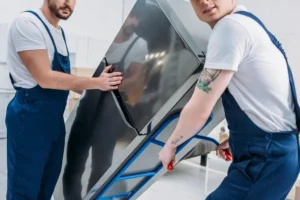How do you move your computer and stuff without breaking anything or losing your important files? Moving electronics like your PC, monitor, keyboard, and other gear needs extra care because they are delicate and can be expensive to replace. If you pack them the wrong way, parts might break, screens can crack, and you could even lose your saved data. There’s also a risk of electric damage if things aren’t unplugged properly. That’s why it’s important to follow simple, safe steps when moving your tech items. Taking the time to prepare or getting help from moving professionals can save you from a lot of stress, damage, and extra costs.
Consider Disassembling Your PC Before Moving It
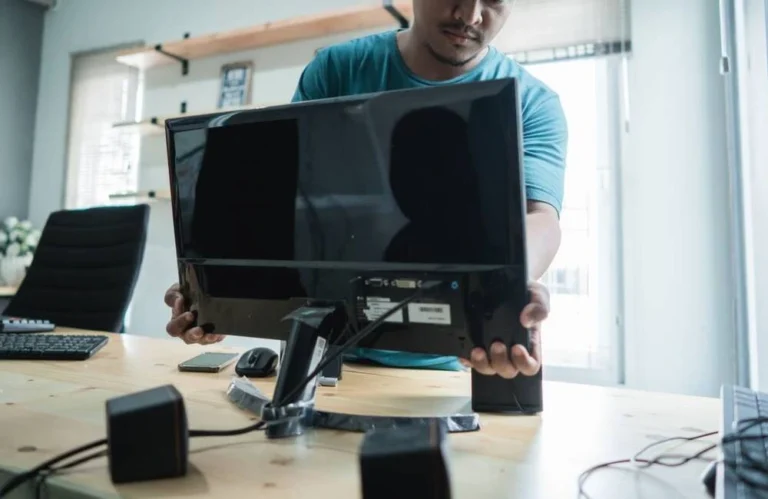
When you’re moving with a PC, it’s a smart idea to disassemble your computer before packing it up. A fully built PC may look sturdy from the outside, but the sensitive internal hardware like the motherboard, GPU, CPU, and RAM can be easily damaged during transport. Especially if you’re moving long-distance or over bumpy roads, disassembly can save you from unexpected repairs or replacements.
Why Disassembling Is Safer for Internal Hardware
PC components are designed to be still and secure in a steady environment not to bounce around in a moving truck. Even the best-cushioned case can’t fully protect delicate hardware when vibrations or knocks occur.
- Motherboard: Can crack or flex if the case is dropped or tilted hard.
- GPU (Graphics Card): It’s heavy and can pull on the motherboard socket or break loose during bumps.
- CPU: Protected under a cooler, but sudden movement might damage the pins or cooler mount.
- RAM (Memory): May loosen and cause issues when restarting your PC after the move.
By taking these components out, you reduce the risk of physical damage and ensure a smooth restart after your relocation.
What to Disassemble Before Moving with PC
Here’s what you should remove for safer transport:
- Graphics Card (GPU)
- Gently unlock the PCIe latch and unscrew it from the case.
- Hold it by the edges and place it in an anti-static bag.
- RAM Sticks
- Push back the clips and lift the RAM sticks out carefully.
- Store them flat in an anti-static bag.
- CPU Cooler
- Unscrew or unclip it carefully.
- Clean off old thermal paste with a dry microfiber cloth (or isopropyl alcohol if needed).
- Store the cooler in bubble wrap or a padded box.
- CPU (optional)
- If you’re experienced, you can remove the CPU from the motherboard socket.
- If you do, make sure to place it in its original plastic case or a small anti-static container.
- Don’t touch the pins those are very fragile.
- Hard Drives and SSDs
- Disconnect and unscrew these.
- Wrap and label them so you remember where they came from.
How to Label and Store PC Components
When moving with a PC, labeling can save you a headache later:
- Use simple paper tags or masking tape to label each component (e.g., “RAM Slot 1,” “Top GPU screw”).
- Place screws in small zip-lock bags and label those too (for example, “GPU screws” or “case side panel”).
- Use a small container or toolbox to keep everything together.
You don’t need fancy tools just keep it organized so you know where each part goes when it’s time to rebuild.
Stay Safe from Static Electricity
One thing you must keep in mind while disassembling your PC for moving is static damage. Static electricity can easily fry sensitive parts like the motherboard or GPU.
Here’s how to stay safe:
- Use anti-static bags for all electronics these are cheap and protect your parts.
- Wear a grounding strap or at least touch a grounded metal object (like your case or a plugged-in PSU that’s turned off) before handling components.
- Work on a clean surface avoid carpets and static-heavy clothes.
Organizing Screws, Cables, and Small Parts
Little things matter. Misplaced screws or cables can delay your setup when you get to your new place.
- Use a pill organizer, small jars, or zip-lock bags for screws and label each one.
- Take a photo of your PC before disassembly to help you remember where cables go.
- Keep cables bundled with twist ties or rubber bands.
- Store everything together in one box and mark it “PC parts fragile.”
You may read about How Much Do Piano Movers Cost?
7 Easy Steps | How Do You Move Your Computer and Stuff
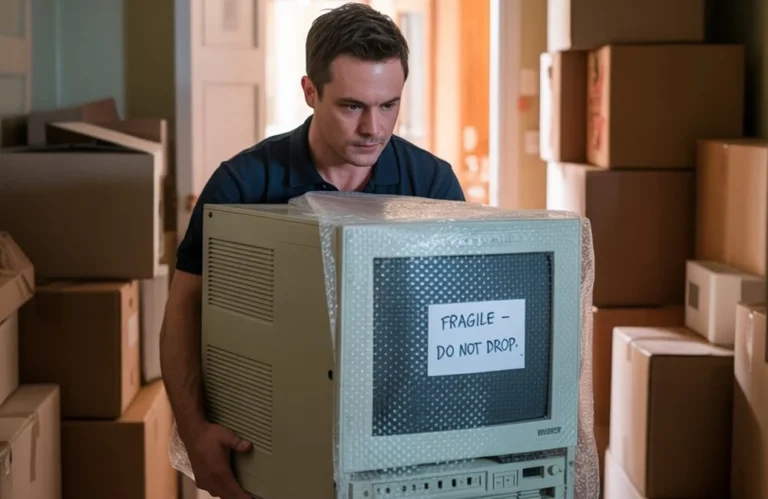
If you’re moving with a PC, monitor, and related devices, it’s important to plan ahead. Computers have delicate components that can be easily damaged during a move. Whether you’re relocating within Los Angeles or specifically in Sherman Oaks, following the right steps can protect your equipment and save you time and money. Here’s a simple, step-by-step guide to help you move your computer setup the right way.
1. Back Up Your Data First
Before you even touch a cable, make sure all your files are safe. Accidents happen, and even a minor bump could cause data loss.
- Create a system image backup of your entire machine.
- Use external hard drives or flash drives to copy important files.
- Think about using services like Dropbox, OneDrive, or Google Drive for cloud backups.
- Double-check that everything is backed up and accessible before you pack anything.
Backing up is your first line of defense if something goes wrong during the move.
2. Shut Down and Unplug All Devices Safely
Don’t rush this part. A proper shutdown ensures your computer closes any running processes and powers down completely.
- Turn off your desktop or laptop fully avoid sleep or hibernate mode.
- Unplug the power cable, monitor cord, and all USB devices.
- Remove detachable items like flash drives, external hard drives, and accessories.
This step protects both your data and the hardware from power surges or cable strain during transport.
3. Label and Organize Cables and Accessories
Once everything is unplugged, it’s easy for cables and small parts to get tangled or lost.
- Use zip ties, twist ties, or Velcro straps to bundle similar cables together.
- Label each one (for example: “Keyboard USB” or “Monitor HDMI”) to make setup easier later.
- Place related items like your mouse, keyboard cables, or charger together in zip-lock bags or small boxes.
- Keep these bags in the same box as your PC or monitor to avoid confusion.
4. Pack the Monitor and Peripherals with Care
Monitors, printers, and keyboards are fragile. They need extra protection during your move.
- Wrap each item in anti-static bubble wrap or a soft cloth.
- If you still have the original boxes, use those they’re designed for safe transport.
- Tape the boxes closed and mark them as “fragile.”
- Stack lighter items like a keyboard on top of heavier ones, never the other way around.
And if you’re moving in Sherman Oaks, consider using our professional packing services. At Chamomile Go, we handle sensitive electronics with extra care and use quality materials to protect your equipment from shock, dust, and static.
5. Use Proper Moving Boxes and Padding
Don’t use a random box just because it fits. The right box keeps your PC and accessories snug and protected.
- Choose a sturdy box that leaves just enough room for padding on all sides.
- Fill extra space with foam inserts, packing peanuts, or soft cloths to prevent movement.
- Never leave your components loose inside the box they’ll shift and may break.
If needed, buy specialty PC boxes online or from moving supply stores to fit your gear more securely.
6. Secure Your Desktop or Laptop Tower
Your PC case protects your parts but only to a point. If you’re moving a desktop tower, secure it from the inside too.
- Place foam pads inside the tower to reduce movement of internal parts (especially for larger GPU units).
- Avoid laying your tower flat. Always place it upright in a padded box.
- Double box if necessary one smaller box inside a larger one filled with cushioning.
Mark the box clearly so movers know it’s sensitive equipment.
7. Transport in a Climate-Controlled Environment
Electronics don’t do well in extreme heat, cold, or humidity. This is especially important in areas like Los Angeles where temperatures can fluctuate.
- Keep your PC and monitor in a climate-controlled vehicle if possible.
- Don’t leave the equipment in a hot trunk or unventilated storage unit.
- Never stack heavy items on top of your computer box it could crack the monitor or damage the motherboard.
When to Call Professionals for Moving Your Computer
If your setup includes expensive, fragile, or complex tech, it’s best to call in professionals. High-end PCs, custom-built rigs, or multi-monitor workstations require extra care that general movers might overlook.
Hiring movers who specialize in electronics or IT equipment can protect your investment. They use proper materials, understand safe handling, and ensure secure transport for items like your GPU, CPU, and monitors.
Before hiring, ask:
- Do you have experience moving computer setups?
- Do you use anti-static packing materials?
- How do you handle delicate internal hardware?
For residents in Los Angeles, Pasadena, Anaheim, Sherman Oaks, and nearby areas, our packing services in Sherman Oaks offer expert handling of all types of tech gear. We use anti-static wraps, sturdy boxes, and careful labeling to make sure your equipment arrives safe and ready to use.
Ready to protect your tech? Contact Chamomile Go today for secure, professional PC packing and moving services.
FAQs
What’s The Safest Way To Move A Computer During Relocation?
The safest way to move a computer is to back up your data first, shut down and unplug all devices, remove sensitive parts like the GPU or RAM if possible, and pack everything using anti-static materials. Using proper padding and boxes helps prevent damage during transit.
Should I Disassemble My Pc Before Moving It?
Yes, disassembling your PC especially parts like the graphics card, RAM, and CPU cooler reduces the risk of internal damage. If you’re not sure how to do it, consider getting help from professionals or refer to your PC’s user manual.
How Do I Pack My Monitor And Keyboard Safely?
Wrap your monitor in anti-static bubble wrap or soft cloths, then place it in a snug-fitting box. For the keyboard and other peripherals, use soft padding and pack them in separate, clearly labeled boxes to avoid scratches or pressure damage.
Is It Okay To Move A Pc Without Removing Internal Components?
It’s possible, but not recommended especially for long-distance moves. Heavy components like the GPU can shift inside the case and cause damage. If you’re moving locally and handling the PC carefully, keeping it assembled might be manageable, but disassembly is always safer.
Can I Use Any Box To Pack My Computer?
Using just any box isn’t ideal. A sturdy, well-padded box that fits your computer snugly is the best option. Avoid boxes that leave too much room or are too tight. Foam inserts, cloth, or bubble wrap can help fill gaps and protect from shocks.
How Do I Organize Cables And Accessories During A Move?
Label each cable using masking tape or tags and store them in zip-lock bags or small boxes. Keep accessories like the mouse, keyboard, and chargers in the same box as the computer or monitor to make setup easier later.
